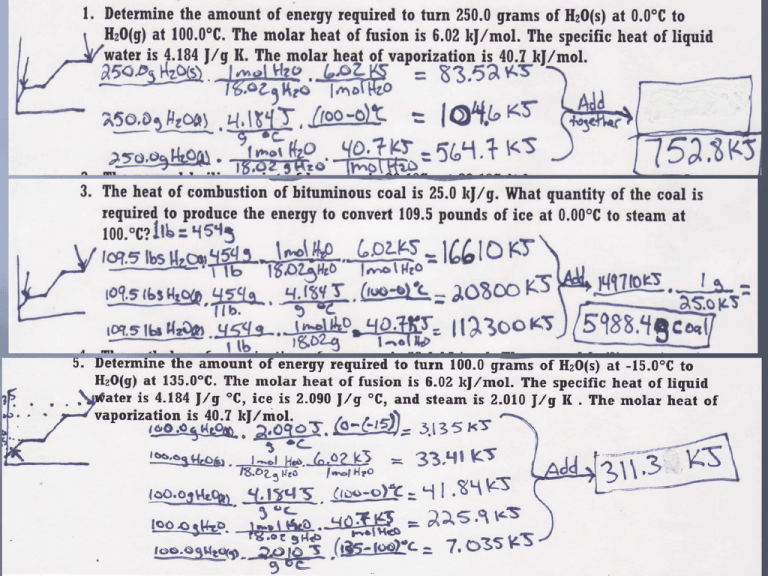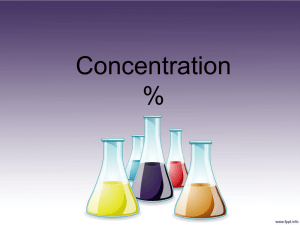Propeties of Solutions PPT
advertisement

Properties of Solutions Classification of Matter Solutions are homogeneous mixtures Solute A solute is the dissolved substance in a solution. Salt in salt water Sugar in soda drinks Carbon dioxide in soda drinks Solvent A solvent is the dissolving medium in a solution. Water in salt water Water in soda Calculations of Solution Concentration Mass percent - the ratio of mass (in grams) of solute to mass (in grams) of solution, expressed as a percent mass of solute ( g ) x 100 Mass percent mass of solution ( g ) Calculations of Solution Concentration Mass/volume (m/v) % - the ratio of mass (in grams) of solute to volume of solution (in mL), expressed as a percent mass of solute( g ) x 100 %( m / v) volume of solution (mL) Calculations of Solution Concentration Volume/volume (v/v) % - the ratio of volume (in mL) of solute to volume of solution (in mL), expressed as a percent volume of solute(mL ) %(v / v) x 100 volume of solution(mL ) Calculations of Solution Concentration Mole fraction – the ratio of moles of solute to total moles of solution nA Mole fraction of A A n A nB Calculations of Solution Concentration Molarity (M) - the ratio of moles of solute to liters of solution moles of solute Molarity M Liter of solution Calculations of Solution Concentration Normality (N) – moles of equilvalents/Liter of solution moles _ of _ equivalents Normality N Liter _ of _ solution Calculations of Solution Concentration Molality (m) – moles of solute per kilogram of solvent moles solute Molality m kilo gram solvent Dissolving Stuff “Like Dissolves Like” Nonpolar solutes dissolve best in nonpolar solvents Fats Benzene Steroids Hexane Waxes Toluene Polar and ionic solutes dissolve best in polar solvents Inorganic Salts Sugars Water Small alcohols Acetic acid Heat of Solution The Heat of Solution is the amount of heat energy absorbed (endothermic) or released (exothermic) when a specific amount of solute dissolves in a solvent. Substance Heat of Solution (kJ/mol) NaOH -44.51 NH4NO3 +25.69 KNO3 +34.89 HCl -74.84 Steps in Solution Formation H1 Expanding the solute Separating the solute into individual components H2 Expanding the solvent Overcoming intermolecular forces of the solvent molecules H3 Interaction of solute and solvent to form the solution Enthalpy Changes in Solution The enthalpy change of the overall process depends on H for each of these steps. Start End Start End Why do endothermic processes sometimes occur spontaneously? Some processes, like the dissolution of NH4NO3 in water, are spontaneous at room temperature even though heat is absorbed, not released. Enthalpy Is Only Part of the Picture Entropy is a measure of: • Dispersal of energy in the system. • Number of microstates (arrangements) in the system. b. has greater entropy, is the favored state (more on this in chap 19) Predicting Solution Formation Solvent/ Solute Polar/ Polar Polar/ Nonpolar Nonpolar/ Nonpolar Nonpolar/ polar H1 H2 H3 + large + large - large + small + large +/small + small + small +/small + large + small +/small Hsol’n +/small Outcome Solution forms + large No solution forms +/Solution small forms + large No solution forms Colligative Properties • Colligative properties depend only on the number of solute particles present, not on the identity of the solute particles. • Among colligative properties are Vapor pressure lowering Boiling point elevation Freezing point depression Osmotic pressure increase Vapor Pressure As solute molecules are added to a solution, the solvent becomes less volatile (=decreased vapor pressure). Solute-solvent interactions contribute to this effect. Raoult’s Law The presence of a nonvolatile solute lowers the vapor pressure of the solvent. Psolution 0 solvent solvent P Psolution = Observed Vapor pressure of the solution solvent = Mole fraction of the solvent P0solvent = Vapor pressure of the pure solvent What is the vapor pressure in mmHg of a solution that contains 155 grams of glucose dissolved in 250. mL of water at 25.00 C? The vapor pressure of pure water at 25.00C is 23.78 mmHg. 22.4 mmHg Liquid-liquid solutions in which both components are volatile Modified Raoult's Law: PTOTAL PA PB A P B P 0 A 0 B P0 is the vapor pressure of the pure solvent PA and PB are the partial pressures At a given temperature, you have a mixture of benzene (vapor pressure of pure benzene = 745 torr) and toluene (vapor pressure of pure toluene = 290. torr). The mole fraction of benzene in the solution is 0.450. Assuming both substances are volatile, calculate the vapor pressure of the solution. 495 torr Colligative Properties of Electrolytes Because these properties depend on the number of particles dissolved, solutions of electrolytes (which dissociate in solution) show greater changes than those of nonelectrolytes. e.g. NaCl dissociates to form 2 ion particles; its limiting van’t Hoff factor is 2. The van’t Hoff Factor, i Electrolytes may have two, three or more times the effect on boiling point, freezing point, and osmotic pressure, depending on its dissociation. Dissociation Equations and the Determination of i i = 2 NaCl(s) Na+(aq) + Cl-(aq) AgNO3(s) Ag+(aq) + NO3-(aq) i = 2 i = 3 MgCl2(s) Mg2+(aq) + 2 Cl-(aq) Na2SO4(s) 2 Na+(aq) + SO42-(aq) i = 3 AlCl3(s) Al3+(aq) + 3 Cl-(aq) i = 4 van’t Hoff Factor One mole of NaCl in water does not really give rise to two moles of ions. van’t Hoff Factor Some Na+ and Cl− reassociate as hydrated ion pairs, so the true concentration of particles is somewhat less than two times the concentration of NaCl. The van’t Hoff Factor • Reassociation is more likely at higher concentration. • Therefore, the number of particles present is concentration dependent. Boiling Point Elevation and Freezing Point Depression Solute-solvent interactions also cause solutions to have higher boiling points and lower freezing points than the pure solvent. Boiling Point Elevation and Freezing Point Depression In both equations, T does not depend on what the solute is, but only on how many particles are dissolved. Tb = Kb i m Tf = Kf i m Boiling Point Elevation Each mole of solute particles raises the boiling point of 1 kilogram of water by 0.51 degrees Celsius. T i K b msolute Kb = 0.51 C kilogram/mol m = molality of the solution i = van’t Hoff factor Boiling Point Elevation The change in boiling point is proportional to the molality of the solution: Tb = Kb i m where Kb is the molal boiling point elevation constant, a property of the solvent. Tb is added to the normal boiling point of the solvent. If I add 45.0 grams of sodium chloride to 500. grams of water, what will the boiling point be of the resulting solution? Kb(H2O) = 0.512 0C/m 101.57 ˚C Freezing Point Depression Each mole of solute particles lowers the freezing point of 1 kilogram of water by 1.86 degrees Celsius. T i K f m solute Kf = 1.86 C kilogram/mol m = molality of the solution i = van’t Hoff factor Freezing Point Depression • The change in freezing point can be found similarly: Tf = Kf i m • Here Kf is the molal freezing point depression constant of the solvent. Tf is subtracted from the normal freezing point of the solvent. If I add 92.0 grams of sodium chloride to 500. grams of water, what will the freezing point be of the resulting solution? K (H2O) = 1.86 0C/m -11.7 ˚ C Solvent Kf Kb Acetic acid 3.90 3.07 Benzene 5.12 2.53 8.1 5.24 Phenol 7.27 3.56 Water 1.86 0.512 Nitrobenzene 52 59 #tryproblem79 Osmotic Pressure Osmotic Pressure • The pressure required to stop osmosis, known as osmotic pressure, , is n =i RT = MiRT (V ) where M is the molarity of the solution If the osmotic pressure is the same on both sides of a membrane (i.e., the concentrations are the same), the solutions are isotonic. What is the osmotic pressure (at 85.0°C) of saltwater that contains approximately 27.0 grams of NaCl per liter with an observed van’t Hoff factor of 1.89. 25.7 atm i i Molar Mass from Colligative Properties 125 mg of an Alkaline Earth metal chloride (XCl2) dissolved in enough water to make 50.0 mL of a solution at 25 ˚C that has an osmotic pressure of 881.6 mmHg. Identify the Alkaline Earth Metal!!!!








